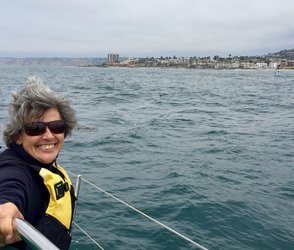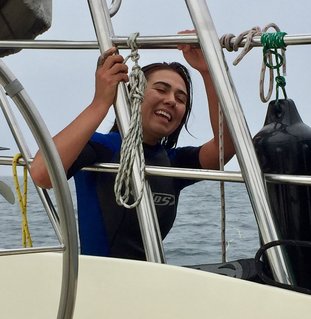|
Not everything works out as planned. But we’re sailors, so we go where the wind, weather and sea take us. Our original idea was an overnight adventure up the coast off San Diego. The wind had other ideas. Jean Moran, Kaya Seewalker and I left the dock early Saturday, June 24. We motored through the moorings, out the harbor, turned right after Point Loma and followed our course line to Mission Bay. We arrived before 11 a.m. and scouted the anchorage. It turned out to be a large field of mooring balls. We considered wind and depth and picked a good spot in the northwest corner. Mission Bay is a 4,600-acre water parkland with 27 miles of shoreline. It’s a busy place. Our next stop was La Jolla Cove and the Shores. The wind was blowing and the big swells rumbled through the area. We had planned to spend time here, but it wasn’t a good anchorage. We did use our depth sounder and found the canyon. Here’s what a Wikipedia entry says about the area: The San Diego-La Jolla Underwater Park spans 6,000 acres of ocean bottom and tidelands. The park's four habitats (rocky reef, kelp bed, sand flats, and submarine canyon) make it a popular destination for snorkelers and scuba divers. The park was created by the City of San Diego in 1970 and actually has two other parks within it: the "look but don't touch" Ecological Reserve and the Marine Life Refuge. Within the underwater park are two artificial reefs, created to attract and enhance marine life. The first was built in 1964 with Santa Catalina quarry rock dumped in 70 feet of water near Scripps Canyon. The second was started in 1975 and is located at a depth of 40 feet just offshore from Black’s Beach From La Jolla Shores the ocean bottom slopes gently out to sea. The reefs keep the waves minimal, making this an entry point for divers and kayakers. Kelp beds on the outer edges of the slope are popular fishing spots and great for observing seals, dolphins, birds and fish. Beyond the slope the bottom takes a sudden and 500-foot (150 m)-deep plunge into the La Jolla Canyon. The canyon reaches depths of 600 feet (180 m) within the park. The abrupt drop and abundance of marine life help to explain why migrating whales can often be spotted close to shore. Though an intriguing place, we decided it would be too uncomfortable to anchor and so set sail to our quiet, remote Los Cornados Island, approximately 28 NM away. We sailed on a broad reach to the island, averaging 6 - 7 knots and arrived just before sunset. The passage was fast and challenging with a downwind swell and confused seas. No one felt like eating except me. I baked a giant chocolate chip cookie, improvising with ingredients on hand. Mighty good. We arrived at our South Coronado Island anchorage just before 7 p.m., and set anchor in 20 knots of wind. To be safe, we lowered 200 feet of Celtic Song’s all-chain rode in 35 feet. That gave us a little less than a 6 to 1 ratio. Plenty to hold us securely.
We were the only pleasure boat there, and we nestled in next to a half dozen Mexican fishing boats near the fish farm. After a light dinner, we all went to sleep to the sound of sea birds and sea lions. It was peaceful. The next morning, Kaya braved the 62-degree water for a swim. We broke anchor and motored sailed in the fog. The wind came up and we had a great sail back into San Diego Harbor.
0 Comments
Leave a Reply. |
|




